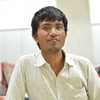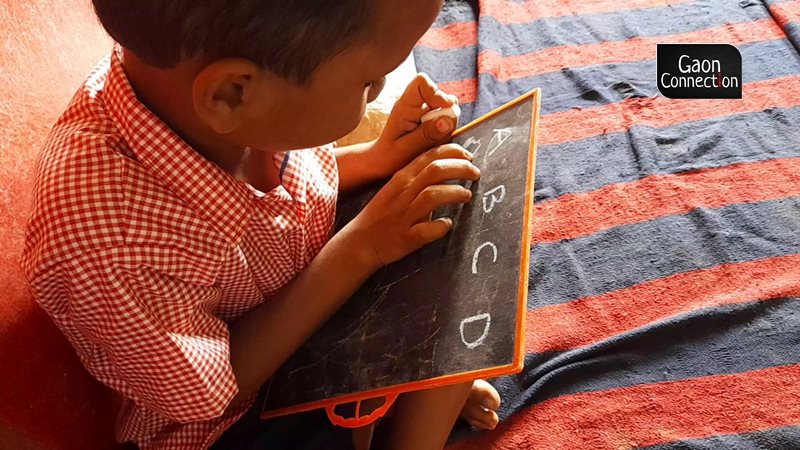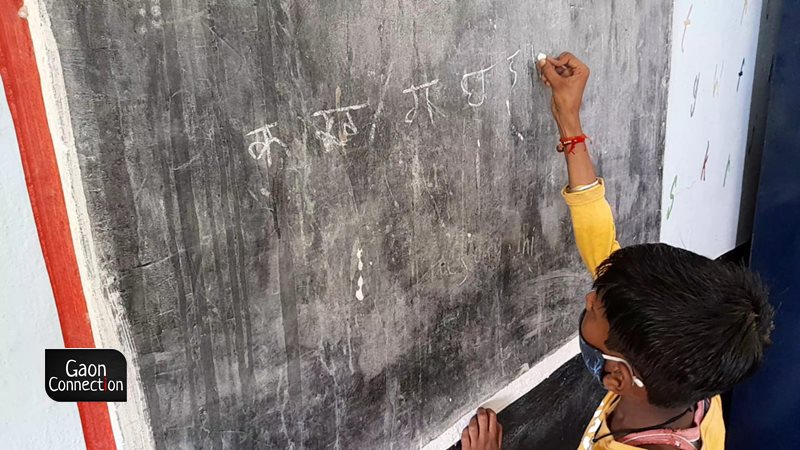Children in Madhya Pradesh struggle to read and write as they return to school
While there is relief in teachers and students that schools have reopened in Madhya Pradesh after 18 months, there is consternation too, as most of the children have forgotten whatever they had learnt before the COVID-19 pandemic. This could prove to be a costly drawback in future learning.


Both students and teachers are struggling to restart the learning process. All photos by Sachin Tulsa Tripathi
Satna, Madhya Pradesh
Suraj Kushwaha had his Hindi text book open in front of him and he peered intently into it trying to make sense of the poem titled Pushp ki Abhilasha (The desires of a flower). The class five student of the Government Primary School, Bardhadeeh in Satna district, Madhya Pradesh, hesitated, stumbled and struggled to articulate the words of the poem.
“It is after one and a half years that classes are recommencing. It is not just a worry but a great challenge that awaits us,” Sushma Tiwari, headmistress, Government Primary School, Bardhadeeh, told Gaon Connection.
As schools reopen in Madhya Pradesh, after remaining shut for almost 18 months due to the pandemic, both students and teachers are struggling to restart the learning process.

India is one of the countries where schools have remained closed for the longest time due to the COVID19 pandemic. Approximately 440 million school students have stayed away from school for nearly 18 months. A few states are reopening schools in a staggered manner while some others are yet to do so.
Less than five kilometres from Suraj Kushwaha’s school, at Kaima Kothar Primary School, Subhash from class five and Shubham of class two shared the same bench. They were asked to read aloud a prayer from the class two text book. Shubham straight away said he could not read while Subhash, who had studied till class five, barely managed to read it.
The teachers in the school are worried. They said both Subhash and Shubham,and other like them, were fairly proficient in reading before the pandemic.
“It is a matter of grave concern. But we have to bring the children up to scratch again,” Rakesh Pandey, headmaster of the Kaima Kothar Primary school, told Gaon Connection.

Also Read: Back To School: Classrooms have reopened in Uttar Pradesh, but where are the textbooks, ask students
Ten-year-old Ashu Ahir from Kitha village in Satna said his school bag and books had remained untouched ever since his school shut down during the pandemic.
“I did not feel like studying when the school was shut. Now, I can’t even remember what I studied when I last went to school,” he told Gaon Connection.
Locked out!
Earlier this month, a survey titled LOCKED OUT: Emergency Report on School Education conducted by School Children: Online and Offline Learning (SCHOOL) was published. According to the survey, students from rural areas and underprivileged homes were the worst affected by the pandemic and consequent school closure for more than 500 days.
While 24 per cent of students in cities attended online classes “regularly’, in the rural areas the number was only eight per cent, found the SCHOOL survey. The reason for this was the lack of smartphones in more than half of the rural households surveyed. The survey was conducted in August 2021 across 15 states in the country and 1,362 students took part in the survey.

According to the SCHOOL survey, 97 per cent of the rural people wanted schools to reopen as soon as possible.
Earlier, in February this year, Azim Premji University published a field study titled The loss of learning for children during the pandemic. The report revealed how reading and writing abilities, comprehension and communication in children had come down.
The study covered 16,067 children in 1,137 public schools in 44 districts across five states.
The February 2021 study focused on the assessment of four specific abilities each in language and mathematics, across classes two to six. The loss of any one of these abilities would have a very serious and adverse impact on further learning.
This Azim Premji University study found 92 per cent of the children showed a loss in at least one specific ability in language, and 82 per cent of them had lost at least one specific mathematical ability.
“We had begun mohalla classes where we showed primary and middle school children educational videos prepared by the state education department,” a primary school teacher who did not want to be named, from Nagod Block, Satna, told Gaon Connection.

“We gathered five children at a time in one of their homes and showed them the films and then asked them questions based on the videos,” the primary teacher added. According to him, while they did these mohalla classes for an entire year, it did not help much. “The closure upset the school routine children were used to, and that was a problem,” said the teacher.
“There is a huge difference between classroom education and online education,” Anjani Kumar Tripathi, former joint director of the education department in Rewa Division of the state, pointed out to Gaon Connection.
“Both teachers and children struggled to adjust to that. In physical classrooms children learn from each other too, whereas during online classes they could be distracted, wandering around the house and not paying attention to what is being said on screen,” he added. Focussing on the lesson ahead is difficult in a virtual classroom, he reiterated.
“Only about forty per cent of students could access the Hamara Ghar- Hamara Vidyalay (Our home, our school) initiative under the Digital Learning Enhancement Programme of the state government’s education department, that was started in 2020,” Vishnu Kumar Tripathi, district project coordinator, Sarva Shiksha Abhiyan, Satna, told Gaon Connection.
While schools have reopened there are still problems remaining. According to headmistress Sushma Tiwari of Bardhadeeh, the school lacks a boundary wall and the fans in the classrooms are not working. The roof leaks too. “We have written to the concerned authorities several times but there has been no response,” she said.
Also Read: COVID-19 exposes fissures in our education system that discriminates against rural kids
“There are five teachers to teach the hundred students in classes one to five,” Tiwari continued.
Things are no better at Kaima Kothar. “There are thirty eight students in classes one to five. Another seven to eight are yet to join as they are unwell. But there are just three teachers,” headmaster Rakesh Pandey said.
Read the story in Hindi

